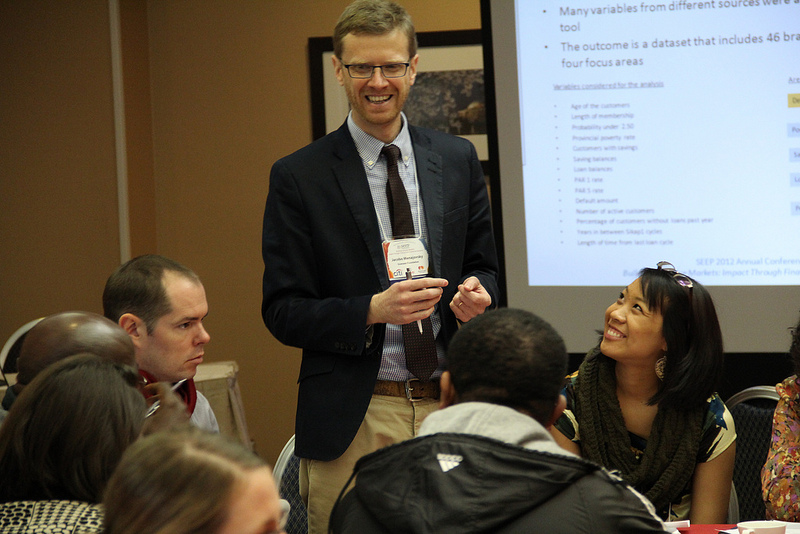2012 SEEP Annual Conference: Using data to inform products and interventions for the poorest
 Poverty is complex. Reaching and empowering the poorest is complex. And oftentimes the most successful interventions are those crafted by the poorest themselves. At the 2012 SEEP Annual Conference, during the session entitled “More than Just Measuring Poverty - Using Data to Strengthen Products and Delivery Channels,” Jacobo Menajovsky of Grameen Foundation and Mary Liz Kehler of Fundación Paraguaya presented two client-led data tools that help inform the design and delivery of products and interventions for the poorest.
Poverty is complex. Reaching and empowering the poorest is complex. And oftentimes the most successful interventions are those crafted by the poorest themselves. At the 2012 SEEP Annual Conference, during the session entitled “More than Just Measuring Poverty - Using Data to Strengthen Products and Delivery Channels,” Jacobo Menajovsky of Grameen Foundation and Mary Liz Kehler of Fundación Paraguaya presented two client-led data tools that help inform the design and delivery of products and interventions for the poorest.

Case Study: Grameen Foundation and CARD Bank
As part of Grameen Foundation’s Microsavings Initiative, a 3-year project funded by the Bill & Melinda Gates Foundation, Grameen Foundation worked with CARD Bank in the Philippines to better understand characteristics of the bank’s clients and the performance of its savings products. Through this work, Grameen Foundation and CARD Bank outlined a comprehensive and iterative analytics process that leverages the bank’s data and implements targeted, client-centered solutions.
Menajovsky and the team set out to understand the following business questions:
- What was CARD’s poverty outreach in its savings portfolio?
- Which other CARD products are clients accessing?
- Is CARD missing opportunities for cross-selling?
Grameen Foundation worked with CARD to update its information management system. This enabled the CARD management team to leverage data on the Progress Out of Poverty Index (PPI), demographic characteristics, and financial information and segment customer types. Menajovsky stressed the importance of understanding the MFI’s objectives and using a combination of product performance and poverty data. Doing so allowed the team to not only to better predict product successes among different customer groups, but to also to appropriately tailor the design and marketing of savings solutions to meet customer needs, as in the example of piloting Matapat, a new savings product. Initially, CARD management set the opening balance at PHP 1,000 (US $23). In the first four months, there was low uptake of the account. In April 2011, CARD dropped the minimum opening balance to PHP 100 (US $2.30). As a result, account openings increased significantly, including among those making under $2.50/day (a rise of roughly 28-33 percent). Although the opening balances declined, the total number of accounts and cumulative balances offset this decrease. The team effectively used the data to understand the effects of product features and make operational decisions to deepen poverty outreach. To learn more, check out Grameen Foundation’s case study entitled Information as Power: Implementing Data Analytics at CARD Bank.
Case Study: Fundación Paraguaya
Mary Liz Kehler presented another example on how data can help inform project implementation. Fundación Paraguaya developed the innovative “traffic light” approach as a strategy for eliminating poverty. This approach centers on a self-evaluation survey tool, which gives the client a comprehensive means not only to measure but plan how to resolve the poverty-related problems affecting his or her family.
Upon forming a village bank, the village bank advisor administers a self-evaluation survey to each client. This survey consists of 50 questions to capture information on the following poverty indicators:
- Income and employment
- Health and environment
- Housing and infrastructure
- Education and culture
- Social organization and civic participation
- Self-awareness and personal motivation
Clients answer each question by identifying which out of the three photos best describes their situation. Fundación Paraguaya then gives the client a “traffic light” report, depicting aspects in which the family is extremely poor (represented by the color red), poor (yellow), and not poor (green). As Kehler explained, the survey data breaks down poverty into discrete problems that have solutions for the client and the village bank, as a whole. Clients can see and work collaboratively on issues as a whole as well as identify positive outliers.
How does Fundación Paraguaya transform this data into a successful intervention? Village bank advisors use an “integral approach” to analyze the underlying causes of a client’s poverty-related problems. This framework breaks the “why” question into actionable items specific to the client’s situation. Interventions are implemented through the “positive influence” methodology. Advisors empower clients through supporting their motivation and ability to adopt behaviors conducive to overcoming poverty on three different levels—personal, group, and structural. With this comprehensive approach, clients become protagonists in their own individualized poverty elimination program. Since piloting the project involving 10,000 families in 2011, Fundación Paraguaya has enabled 6,400 families and an estimated 32,000 beneficiaries to increase family income above the national poverty line.
The session then gave participants a chance to interact with the tools and internalize the case studies presented. Menajovsky led a group that simulated how to craft targeted interventions through data analysis. Kehler facilitated a scenario where participants used the key tools in the “traffic light” approach.

